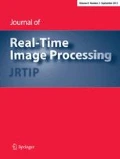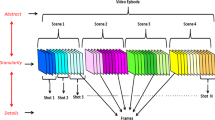Abstract
Video signals are a very important part of multimedia applications. Due to limited network bandwidth, video signals are subjected to the compression process, which introduces different compression artifacts. During network transmission, additional artifacts are introduced in video signals due to random bit errors and packet loss (PL). Both mentioned artifact types degrade visual quality of the video signal and thus, it has to be continuously monitored to ensure the required quality of service (QoS) provided to end users. An important component of the video quality monitoring system deals with video transmission artifact detection. In this paper, a no-reference (NR) pixel-based video transmission artifact detection algorithm is proposed, called the packet loss area measure (PLAM) algorithm. When detecting video transmission artifacts, the PLAM algorithm takes into account spatial and temporal information of a video signal. The performance of the proposed PLAM algorithm has been compared to those of the three existing different PL detection algorithms on a broad set of significantly different video signals from two publicly available video databases. One of these databases, called the Referent Packet Loss (RPL) database, has been created within this research and is presented in this paper. The algorithm performance testing results show that PLAM achieves high performance and overcomes other tested algorithms. Furthermore, the results show that the PLAM algorithm is very robust when detecting video transmission artifacts in video signals of different contents, with distinct degradation levels and PL error-concealment methods used in decoder post-processing. Due to its low computational complexity, the PLAM algorithm is capable of processing Full HD and Ultra HD video signals with the frame rate up to 100 and 25 frames per second (fps), respectively, in real time, in the case when high-end CPU is used.















Similar content being viewed by others
References
Shabtay, D., Raviv, N., Moshe, Y.: Video packet loss concealment detection based on image content. In: 16th European signal processing conference, Laussane (2008)
Juurlink, B., Alvarez-Mesa, M., Chi, C.C., Azevedo, A., Meenderinck, C., Ramirez, A.: Scallable parallel programming applied to H.264/AVC decoding. Springer, New York (2012)
Lin, T.L., Ding, T.L., Fan, C.Y., Chen, W.C.: Error concealment algorithm based on sparse optimization. Multimedia Tools Appl. 76(1), 397–413 (2017)
Glavota, I., Vranješ, M., Herceg, M., Grbić, R.: Pixel-based statistical analysis of packet loss artifact features. In: Zinc conference, Novi Sad (2016)
Leszczuk, M., Hanusiak, M., Farias, M.C.Q., Wyckens, E., Heston, G.: Recent developments in visual quality monitoring by key performance indicators. Multimedia Tools Appl. 75(17), 10745–10767 (2016)
Paul, S., Pandit, M.K.: A QoS-enhanced intelligent stochastic real-time packet scheduler for multimedia IP traffic. Multimedia Tools Appl. 77(10), 12725–12748 (2018)
Khalifeh, A.F., Al-Taee, M.A., Murshed, A.N.: Network-status aware quality adaptation algorithm for improving real-time video streaming over the internet. Multimedia Tools Appl. 76(24), 26129–26152 (2017)
You, J., Xue, H., Gao, L., Zhang, G., Zhuo, Y., Wang, J.: Predicting the online performance of video service providers on the internet. Multimedia Tools Appl. 76(18), 19017–19038 (2017)
Hu, Z., Zhang, Q.: A new approach for packet loss measurement of video streaming and its application. Multimedia Tools Appl. 77(10), 11589–11608 (2018)
Wang, J., Hou, Y.B.: Packet loss rate mapped to the quality of experience. Multimedia Tools Appl. 77(1), 387–422 (2018)
Orosz, P., Skopko, T., Varga, P.: Towards estimating video QoE based on frame loss statistics of the video streams. In: International symposium on integrated network management, Ottawa (2015)
Babu, R.V., Bopardikar, S., Perkis, A., Hillestad, O.I.: No-reference metrics for video streaming applications. In: 14th international workshop on packet video, Irvine (2004)
Rui, H., Li, C., Qiu, S.: Evaluation of packet loss impairment on streaming video. J Zhejiang Univ. Sci. B 7(1), 131–136 (2006)
Teslić, N., Zlokolica, V., Peković, V., Teckan, T., Temerinac, M.: Packet-loss error detection system for DTV and set-top box functional testing. IEEE Trans. Consum. Electron. 56(3), 1311–1319 (2010)
Ong, E.P., Wu, S., Loke, M.H., Rahardja, S., Tay, J., Tan, C.K., Huang, L.: Video quality monitoring of streamed video. In: IEEE international conference on acoustics, speech and signal processing, Taipei, Taiwan (2009)
Montard, N., Bretillon, P.: Objective quality monitoring issues in digital broadcasting networks. IEEE Trans. Broadcast. 51(3), 269–275 (2005)
Joskowicz, J., Sotelo, R.: Measuring the incidence of packet loss on video quality in digital television. In: IEEE international instrumentation and measurement technology conference (I2MTC), Montevideo, (2014)
Pauliks, R., Slaidins, I., Tretjaks, K., Krauze, A.: Assessment of IP packet loss influence on perceptual quality of streaming video. In: Asia Pacific conference on multimedia and broadcasting, Bali (2015)
Greengrass, J., Evans, J., Begen, A.C.: Not all packets are equal, part 2: the impact of network packet loss on video quality. IEEE Internet Comput. 13(2), 74–82 (2009)
Manasa, K., Manasa Priya, K.V.S.N.L., Channappayya, S.C.: A perceptually motivated no-reference video quality assessment algorithm for packet loss artifacts. In: Quality of multimedia experience, Singapore (2014)
Yamada, T., Miyamoto, Y., Serizawa, M.: No-reference video quality estimation based on error-concealment effectiveness. In: Packet Video, Lausanne (2007)
Zhang, D., Zhou, D., Jin, X.: A content-adaptive video quality assessment method for online media service. Multimedia Tools Appl. 76(5), 7175–7195 (2017)
Wang, Z., Wang, W., Xia, Y., Lin, W.: No-reference hybrid video quality assessment based on partial least squares regression. Multimedia Tools Appl. 74(23), 10277–10290 (2015)
Chen, Z., Liao, N., Gu, X., Wu, F., Shi, G.: Hybrid distortion ranking tuned bitstream-layer video quality assessment. IEEE Trans. Circuits Syst. Video Technol. 26(6), 1029–1043 (2016)
Zhao, S., Jiang, H., Cai, Q., Sherif, S., Tarraf, A.: Hybrid framework for no-reference video quality indication over LTE networks. In: 23rd wireless and optical communication conference, Newark (2014)
Kim, S.J., Chae, C.B., Lee, J.S.: Subjective and objective quality assessment of videos in error-prone network environments. Multimedia Tools Appl. 75(12), 6849–6870 (2016)
Kordelas, A., Politis, I., Dagiuklas, T.: Transport analysis and quality evaluation of MVC video streaming. Multimedia Tools Appl. 75(10), 5619–5644 (2016)
Zhou, S., Lu, Z., Wen, F., Shao, H., Chen, Y.: Bursty interference-oriented video quality assessment method. Multimedia Tools Appl. 75(5), 2741–2768 (2016)
Video multi-method assessment fusion by Netflix (online). https://github.com/Netflix/vmaf. Accessed 6 Sept 2018
Bampis, C.G., Katsavounidis, I., Bovik, A.C.: Recurrent and dynamic models for predicting streaming video quality of experience. IEEE Trans. Image Process. 27(7), 3316–3331 (2018)
Lin, J.Y., Liu, T.J., Wu, E.C.-H., Kuo, C.-C.J.: A fusion-based video quality assessment (FVQA) index. In: Asia-Pacific signal and information processing association annual summit and conference, Chiang Mai (2014)
Bampis, C.G., Li, Z., Bovik, A.C.: SpatioTemporal feature integration and model fusion for full reference video quality assessment (2018). arXiv:1804.04813
P.910: Subjective video quality assessment methods for multimedia applications (online). https://www.itu.int/rec/T-REC-P.910-200804-I/en. Accessed 25 Feb 2018
Xiph.org: video test media [derf’s collection] (Online). https://media.xiph.org/video/derf. Accessed 25 Feb 2018
Video analysis (Online). http://bbt.rt-rk.com/audiovideo-analysis/. Accessed 25 Feb 2018
Acknowledgements
This work was supported by Josip Juraj Strossmayer University of Osijek business fund through the internal competition for the research and artistic projects IZIP-2016, via the project “Providing of digital video signal based services in rural and rarely populated areas”.
Author information
Authors and Affiliations
Corresponding author
Rights and permissions
About this article
Cite this article
Glavota, I., Kaprocki, Z., Vranješ, M. et al. No-reference real-time video transmission artifact detection for video signals. J Real-Time Image Proc 17, 799–820 (2020). https://doi.org/10.1007/s11554-018-0824-6
Received:
Accepted:
Published:
Issue Date:
DOI: https://doi.org/10.1007/s11554-018-0824-6




